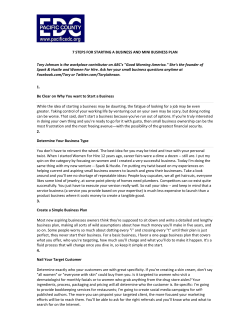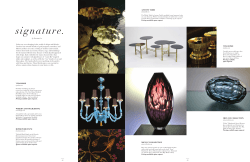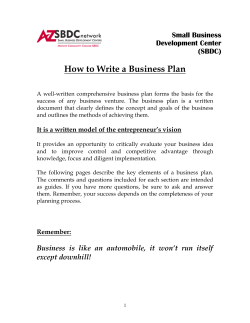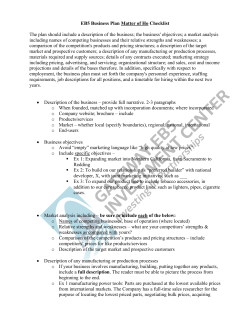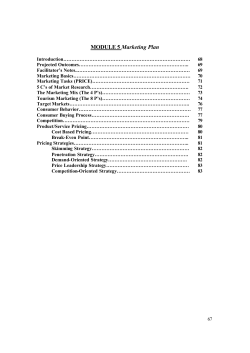
raise your freelance rate by How to adopting a value-led pricing structure
How to raise your freelance rate by adopting a value-led pricing structure by Liam Veitch About the author I’ve grown my freelance business into something I am truly proud of, yet I know the feeling of battling as a freelancer all-too-well. Following an initial failure I tried again with a renewed mindset and I teach everything I know at freelancelift.com. It took me one failure at the freelance game and a 2 year sentence as a zombie-herd employee at a corporate to figure it out, now I want to give you the benefit of my experience as well as inviting you into the world of the people who have been there and broken the freelance boundaries themselves. Most freelancer advice sucks; particularly when it comes to pricing, so in this free guide I want to show you how to beef up your rates by being really clear about the value you provide and leading with that rather than an arbitrary hourly rate. Nice freelancers finish last 1 The truth about hourly rates I’ve long held the belief that “doing okay” freelancers are enslaved by a self-imposed earnings ceiling. Indeed, I put together a whole video on that very topic which at the time of writing has amassed over 30,000 views. The truth is most freelancers don’t earn anywhere close to that earnings maximum. It’s not because their rates aren’t high enough and probably not because their work isn’t good enough. It’s simply that they either fail to find the clients to fill those x hours per month or exceed the hours they do promise to those clients without further billing. Indeed, the very model they work to can only end in disappointment. The cold hard truth about hourly rates is that they don’t matter. Moreover the further up the ladder you go, the less time-based pricing even plays a part. I call this the freelancing ‘Pyramid of Excellence’. Have you ever wondered why you don’t see A list freelancers on Elance? Experienced freelancers who dominate a space or are reputed within their industry have figured out that the only thing a great client really cares about is how much their work benefits their business. What I want to address in this book is a major issue that aspiring freelancers have. In a nutshell, we’re talking about pricing and pitching your work in such a way that it frames the value you provide and makes it a difficult proposition for your prospective clients to turn down. Hourly Rates Don’t Matter 4 In a recent chat I had with author of the book ‘Double Your Freelancing Rate’ Brennan Dunn, we talked specifically about this issue. Indeed, Brennan managed a larger consultancy before deciding to go freelance and now tells his story via his podcast and books. Here’s what he says on the issue: “Nobody was ever hiring me just because I knew how to write code, they’re hiring us to solve a problem that exists in their business. The coding was the medium to get to that goal, when I focused on the goal rather than the skill it made it easier to justify my services as an investment.” In this short guide I’m going to walk you through my methodology for pitching freelance services. In doing so I hope to enable you to overcome your own fears on pricing and enable you to think a little differently when preparing that next proposal. Hourly Rates Don’t Matter 5 Why they don’t buy Pricing your work isn’t easy. You only have to run a couple of searches in and around freelancer pricing and you’re over-run with contradicting posts and so-so advice. In the end you go with something that’s little more of a ‘gut’ reaction based on best case scenario time estimates multiplied by a low-enoughto-be-attractive hourly rate. With this model we’re severely weakened before we even begin. Firstly we almost always all under-estimate how long a project will take and second, we pitch low on hourly rates to ensure it ‘feels’ right to the client. This is all compounded when we agree to drop the price by 20% at the slightest sniff of a less than favourable response. This is the life of a freelancer. Sucks huh. It doesn’t have to be that way. Hourly Rates Don’t Matter 7 To help you get a little perspective on this, I want to give you some reasons your clients DON’T buy. You’ll notice that price in isolation is not a factor. Sure, you have to be competitive and realistic but what is realistic anyway? Is $10k a realistic price for delivering $20k in profit for a client? Sure. Does the client care whether it takes you 10 hours or 1000 hours to achieve that goal? Of course they don’t. Ultimately if you are getting pricing objections its an issue with the value proposition you’ve put forward, not an issue with the price itself. It is your responsibility to justify the perceived value of your service. We’ll go onto that shortly but first, let’s take a look at why prospective clients don’t buy: In doing so I’ll give you 5 quick tweaks you can make right now to tackle client objections before they arise, repositioning your message to get solid commitment where before there was only a luke-warm handshake. Stacking these tweaks will give you the compound changes required to make your freelance clients value, and then WANT what you’re offering, ensuring you can take a shortcut to the top of the pyramid of excellence. Hourly Rates Don’t Matter 8 1. You’re not addressing their specific concerns in your site / proposal content This one is pretty obvious, but so few get it right it needs to be covered here. There is a sweet spot between where your prospect is right now (current situation) and where they want to be (ideal situation) that, if addressed multiplies your chances of getting the outcome you’re looking for. The objective of your service is to take your customers from their current situation to their ideal situation but it’s amazing how few freelancers actually point that out within client facing messaging. Your priorities are putting together a tight specification which covers off the fundamentals. You’ve probably copied / pasted from previous proposals even. The client doesn’t really care about the details. They need to know that you visualize their upside and can make it happen. Rework your proposal content to ensure that the upside comes first. Ensure that your pitch addresses and overcomes: Hourly Rates Don’t Matter 9 > What outcome do they desire and are you addressing how your service will solve that? > What would they want out of your service and how do you deliver? > Does your content address the challenges the prospect believes they have? > Does your proposal address the benefits they believe someone of your skillset can provide? > Which fears have brought them to your door and how might you overcome them together? By just reworking your thinking a little more in terms of what a client expects and desires can help you create a powerful message that begins to justify any pricing model. If you’re still copying the intro from previous proposals you are regurgitating a message which tries to be all things to all prospects, often serving no one person fully, this all contributes to a lack of excitement on the part of the client. Hourly Rates Don’t Matter 10 2. They don’t clearly understand why they need you Your client knows they need a web designer. They know they need a writer, developer or marketer. But do they fully understand why they need you, specifically? It’s interesting how freelancers as a group are so used to being ‘one in several thousand’ that we fail to shout about how different we are to that other 99%. There are several million bands out there, but do you ever hear record companies describing their artists as anything other than fresh, interesting and unique? You should be clear and specific about why you specifically can help the client achieve their goals. Believe me, if they are receiving 10 proposals almost none will explicitly create a value proposition that clearly states why they should look no further. Instead they’ll have 10 that echo with superlatives and details around the features of the service itself without addressing the upside and the clear argument for looking no further. It’s the difference between: “I make websites” “I boost your revenue by designing websites that convert, I’ve done that for XYZ in your space so I’m confident that I’m the best fit for achieving your goal of XYZ” Hourly Rates Don’t Matter 11 3. They don’t value it I’m always surprised how few businesses actually push the emotional buttons that make for buying decisions. If in doubt, go find some classic infomercials on Youtube for a masterclass on triggering an emotional “I need this” response, you’ll probably find it in the first 10 seconds of each one. I’m not suggesting you ham it up as much as this but you should be able to idenfity with real issues your prospect is encountering. You should pull at those pains before presenting you as the solution. As you’ve been able to define exactly what problems your service solves and you’re speaking in such a way that echoes the language of your prospect you are in a position to begin making them value what it is you’re offering. 4. They don’t believe you This applies whether you do business online, in person or whether at this point you’re faced with a prospect on your website considering getting in touch. You should introduce trust indicators that put you in control of the conversation. Leave nothing to chance and be open about your successes. Hourly Rates Don’t Matter 12 Here are some ideas: If you can, use video it’s much easier for your prospect to identify with the human emotion within the testimonial. This is a killer technique. This is the next best thing, but for extra cayenne pepper include a link with the option to “don’t take our word for it, contact this person yourself ” for a verified response. You’ll be surprised how few people will take this up, but the mere offer of a direct email to one of your customers is so powerful. An easy way to validate that you are the real deal is to check out your social standing online. If you are active in the community and have some solid social proof you’re going to certify yourself as a provider of repute. Sometimes it’s difficult to see the wood for the trees as this technique is used so frequently but in certain tech situations it does carry some clout! Are you validating your claims with easily verified trust factors and introducing these into your proposal strategy? Hourly Rates Don’t Matter 13 5. You’re not giving them a no brainer opportunity to kickstart a relationship We’ve been able slicken the flow so there is less opportunity for your prospect to go passive. Now it’s about hitting them with the no brainer opportunity. This no brainer exists to advance the sale and compounds all other elements before it. You’ll have put together lots of value already but here is where you need to make the clincher. Taking price out of the equation, probably the number one cause for prospects to go cold is an apathy on the part of the client. The project is delayed, they go back to the drawing board, the idea is re-prioritised. That means nobody has given them an offer they’d be stupid to turn down. If you can position your proposal so that it has a killer call-to-action which advances the likelihood you’ll have a great chance of doing more deals and at the right pricepoint. This can take many forms: A free session where you and prospect walk through how you can start and what your vision is for the project. Your job here is to get the prospect really excited about doing this. So excited in fact they commit to the job after the meeting. Hourly Rates Don’t Matter 14 For a designer this would be an introductory visual concept. You’re essentially giving them a glimpse of how the project might go, before it even starts. If you do a great job of giving them some excitement in advance you’ll ensure that excitement carries through to commitment. Tread carefully with this one. The name says it all, but if you are confident in what you are delivering and you can justify the risk of pay on performance it can prove to be the no brainer required to push a client into buy mode. When you spell out the reasons your client doesn’t buy, it begins to give clarity on what pushes their ‘buy’ button. At this juncture its important to ensure we’re on the same wavelength here when it comes to being comfortable with value-led pricing. Hourly Rates Don’t Matter 15 Understanding value-led pricing Whether you know it or not, pricing is almost always value-led. The price you are comfortable paying for something is directly related to the value you feel you’re going to get from it. “Price is what you pay. Value is what you get” Warren Buffett If everyone bought on price alone without appreciation of value we would all drive a Datsun. Therefore if your price is deemed too high, in your clients’ eyes your value is deemed too low for your pricepoint. The amazing paradox here is that you control the value your client perceives; hence it is you who dictates whether a price is too high. In the last chapter we looked at how to build value. Specifically by overcoming the key factors that undermine your perceived value and cause clients to say no. But how do you put a price on that? Hourly Rates Don’t Matter 17 When we talk value-based pricing it is always a fixed project fee. This may feel alien right now so in this section we’ll look to ensure this is the new norm. Pitching a price beyond your comfort zone is something I do not advise. If you are not 100% confident in your price and you feel that in some way its over-inflated or unfair you’ll drop it at in a heartbeat, undermining your value proposition significantly and often irreparably. So you need to ensure that you have justified the price yourself first before unveiling it to a client. This really revolves around the mindset fix of feeling comfort in billing a fixed fee which is justified by the impact your services will have on a client’s business. After all, if you are helping a business to fulfill its goals, isn’t it only right that the business helps you to fulfill yours? Hourly Rates Don’t Matter 18 I advocate switching sides of the desk, to begin to look at your pricing from the point of view of your client. This helps for two reasons. It allows you to fine-tune your messaging so that there is no element of doubt in your client’s mind that you are the right person for this job and more importantly it helps to give you clarity on the cost:benefit decision the client will have to make. Its important to know your prospect’s market intimately. If you do have the opportunity to scope out the project prior to building the proposal try and get as much detail as you can as to the upside your client expects from this new project. Some great questions to ask are: > What is your average customer worth? > Will this logo/website/application/ebook/content make it easier for you to get clients? > Will this save you time? How much? > What does success look like to you? > What is holding you back from hitting the targets you currently have do you feel? Leveraging these techniques will give you the comfort you need to justify in your own mind the basis for your new pricing structure, along with ammunition you can build into your messaging when it comes to creating the proposal. Moreover you’re already building a sense of collaboration and trust between you and your prospective client. Hourly Rates Don’t Matter 19 If you were asked to measure the volume of an iceberg, you’d have to start with the bits you could see I liken this to the cost-plus (hourly rate) pricing model. You are billing for what the client can see, only at that moment in time. But what about the years spent learning, tools you’ve invested in, things you’ve sacrificed? What about the expertise, experience and value that lies beneath? By billing only on what is above the surface at that moment in time you are undervaluing the rest of what makes you, you. Top bracket freelancers understand deeply that even though they do estimate the length of time it takes to work on a project this ‘time’ expense does not define them or their cost, they are not a collection of hours, they are an asset. This sense of pride and appreciation of what lies beneath enables them to be infinitely comfortable with their pricing structure, even if the math ends up showing $150 per hour on the project. Pricing is trivial once value has been justified, so create your own price, move away from a commodity-based pricing model and meet the goals have. Hourly you Ratesyourself Don’t Matter 20 Crunching the numbers Justification is a word used frequently when it comes to pricing. This works hand-in-hand with value. Once value and desire has been established you just have to justify the cost within the context of the monetary upside and this is the final hurdle. In the first instance its up to you to discuss pricing only in terms of an investment, not an outright expense. This investment has an upside and its up to you to explicitly define that. Once you have defined that monetary upside you should look to frame an “investment” which is anywhere from 10-20% of that upside. I often speak on this topic and have questions from service providers who offer services which seemingly offer no monetary upside. The good news is this is very rarely the case. With a simple exercise called ‘So that’ you can normally dig your way to the monetary aspect. Hourly Rates Don’t Matter 21 Here are a couple of examples: “I’m creating a new logo” So that? “So that it modernizes my business branding” So that? “Well, so that I can have a more credible brand” So that? “Umm, so that people would be more likely to trust my company” So that? “So that I get more customers” Gotcha Once you get to that bottom-line benefit, and if you have a clear handle on what a customer lifetime value is you can begin to justify a cost based on that. “I need a VA” So that? “So that I have some support with admin” So that? “So it saves me time” So that? “So that I can spend 10 hours per week on other activity” Gotcha Hourly Rates Don’t Matter 22 Time-based is a great one, it’s really simple to justify the upside of having more time from the client’s point of view. They either have more time to make revenue (in which case you calculate the value of this new-found time based on how many new customers they could gather), or more time to work less (in which case they would be comfortable paying anything up to what they would otherwise earn chained to the desk). Either way this is a higher upside for a lower cost, this is the heart of an “investment” and the heart of value-led pricing. Hourly Rates Don’t Matter 23 Bringing it all together. A structure for your next proposal When it comes to building out a value-based pitch you really only need to do three things: 1. Build value 2. Justify the investment & upside 3. Ask for the sale The purpose of this book is to give you a holistic view of the valuebased pitch landscape so it would be remiss of me to leave you without a structure guide to building out a kick ass proposal. So here it is. Section 1: Pace the problem Does your prospect have a problem getting new customers? Are they suffering from a lack of time? Whatever their main pain is here you need to pace it; ensure you’re showing them descriptively their problem. What impact is that having on their business right now? What does this pain cause them not to do? Hourly Rates Don’t Matter 25 Section 2: Echo desires, beliefs & fears This would otherwise be referred to as the ‘Project objectives’. Going back to chapter one we looked at why clients don’t buy. Often its simply because you’re not addressing their primary concerns. What beliefs do they have about how you can help, what are their fears for getting this decision wrong? You should build empathy in this section by making it clear you’re fully on board with what they’re trying to achieve and have a counter-argument for each potential objection spelled out. Section 3: Make them believe you In this section you want to leave no doubt in the prospect’s mind that you can walk the walk as well as you talk the talk. Here is where you’d talk about successes you’ve had on similar projects, your reputation within the space and how this directly relates to the work you’re pitching to win for the prospect. Section 4: Make them value you It’s amazing how few freelancers actually give their own story some airtime. Stories often are the best way to put points across; moreover it builds trust and empathy that is difficult to replicate by other means. You should ensure you relate any story about your background to the prospect and their particular problem. Your objective here is to make the prospect value the impact you specifically would have to this project. Hourly Rates Don’t Matter 26 Section 5: Provide the details It wouldn’t be a proposal without some finer points. At this point if you’re in web it’ll be the technical aspects, otherwise you’re just being clear about what the prospect will get in return. Section 6: What does victory look like? If your prospect cannot clearly visualize the successful finish you’re going to find it difficult to keep them engaged with your pitch. At this point we’re building up to the price reveal, so its important to ramp up the excitement. Ultimately a prospect has a subconscious eye on ‘what difference will this make to me?’ ‘Why will this make my life better?’. Your job here is to answer that, respond strongly and begin to justify the investment. Section 7: What is the upside? Now we’re getting into specifics. Sure, quality of life is an important factor but we need to enable a rational decision making process by spelling out the financial upside. You can look as far into the future as you need to here, dependent on the service you’re carrying out. You may express the upside as a month-to-month figure i.e. “By doing XYZ you’ll be saving around $1k per month in saved productivity” or you might want to justify your investment as a longer-term play i.e. “By redeveloping the site, and upping the conversion rate to 3% you’ll be in Hourly Rates Don’t Matter 27 a position to generate an additional $100k over the next 12 months”. Pick whichever suits your payment structure and the natural longevity of the investment. If you really don’t feel comfortable picking precise figures, or you just haven’t been able to gather specific enough information you should be spelling out the beneficial factors here in terms of business growth, brand awareness, whatever and allowing your prospect to join the dots in terms of what the value is to them. You will have a ‘sense’ of what this upside is yourself but if you don’t feel comfortable putting it down you can leave it out, just ensure this forms the basis of your pricing. Section 8: What is the investment? Here is where you pitch your cost, if you’ve done everything right to this point the price should be trivial. Providing you have fully justified the value you are bringing to the table and the investment is proportionally fair to the upside you have a very good chance of making the deal. You can go anywhere from 5% to 25% of the upside here, but most common is 10-20%. Hourly Rates Don’t Matter 28 Section 9: Make it easy to say yes We talked about building no brainer opportunities in the second chapter and this is where we will wield that particular sword. Even if your service does not lend itself to excitement-in-advance methodology you should still be making it easy for your client to say yes. Sure, you’ll probably need to have a project initiation meeting, sure you may need to get content or more information before you start and to be set up with an email address or whatever but mention it here at your peril. By adding unnecessary complexity to ‘saying yes’ you add distractions. “Oh shoot, John from tech is on holiday for two weeks, if you need that email address maybe we’ll need to hold off til he’s back”. Just get the commitment first, deal with the obligatory onboarding bits later. Section 10: Assume the sale This is sales 101 stuff, but its high on sales training lists because it works. If you can lead your prospect so far down a path that psychologically they’ve committed you control the closing process. Example: “So upon signature I will just raise the first 50% invoice that covers everything up to when we launch, when the other 50% is due and you’re completely happy – who would I address that first invoice to?” Hourly Rates Don’t Matter 29 You’ll find your prospect clambering for a name rather than say “hang on a minute, I haven’t hired you yet”. To be clear, each one of these sections doesn’t need to be horrendously long, nor does it need to add anything more to your current sales process. Often proposals are put together more for the benefit of the freelancer than the client. The objective of a value stacked proposal like the one I’ve laid out above is to reverse that. Hourly Rates Don’t Matter 30 Summary and getting started Billing on a fixed rate project basis is the key to raising your rates to levels you just couldn’t attain on a cost plus model. Indeed, your ‘rate’ actually becomes irrelevant because you value what you do and can clearly justify that value and impact to prospective clients. Sure, you may want to ease yourself into this and sure, for some clients price is the only factor they care about but who really wants that client anyway? Here are some takeaways if you skipped straight to the end: If you’re billing on the value you provide time is no longer a factor. You should bill for the completion of a project. If that project is inherently time related however, you should bill based on a significant chunk of time, so the ‘project’ in this instance would be the next quarter of activity. Remember, the price a client is comfortable paying is directly related to the value they feel they’re going to get from it. You control this perceived value in the communication and pitch you put in front of your clients (the same is true for existing clients) so ultimately it is you Hourly Rates Don’t Matter 32 who defines how much you’ll earn this year. If you know your prospect’s space deeply you have the inside track on what makes them tick, what an average customer is worth and how your work will make an impact. If you do not have this information banked then discovery is a really important phase. By understanding deeply what a client is looking to achieve from this project you can put monetary figures to the upside your work brings. Often for web-based freelancers your pitch is delivered in a PDF format so its crucial you create a killer document that covers all 10 of the key aspects we looked at in the previous chapter. You don’t often have the opportunity to sit in front of a client and allow them the ‘sense’ how you are as a person so you need to tell them why they need you, what you’re bringing to the table and ultimately why this investment if justifiable. I want to hear from you. Hit me at liam@freelancelift.com when you’ve successfully implemented the pitch strategy I’ve laid out above. There is a lot of contradictory advice on pricing so the objective of this book was to lay out, in a format that isn’t so overfacing how to get the best out of value-based pricing so you can earn more and break through that earnings ceiling. Hourly Rates Don’t Matter 33 Head to freelancelift.com for more content like this This was a free playbook for subscribers at freelancelift.com. You are authorised to share this content on social media and by email by crediting the original source @freelancelift.
© Copyright 2025
